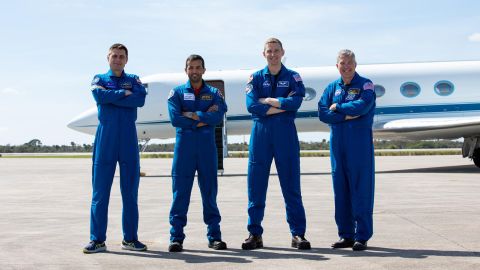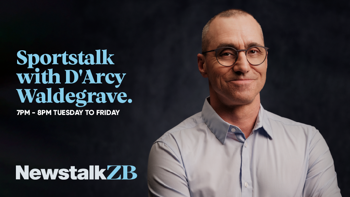
CNN — SpaceX and NASA are once again preparing to launch a fresh crew to the International Space Station after the first attempt to get the astronauts off the ground was thwarted in the final moments by a clogged filter.
The mission — which will carry two NASA astronauts, a Russian cosmonaut and an astronaut from the United Arab Emirates — is now slated to lift off at 12:34 a.m. ET Thursday from NASA’s Kennedy Space Center in Cape Canaveral, Florida.
The Crew Dragon, the vehicle carrying the astronauts, will detach from the rocket after launch and spend about one day maneuvering through orbit before linking up with the space station. The capsule is slated to dock at 1:17 a.m. ET Friday.
The issue that had left the first launch attempt grounded on Tuesday was resolved by early Wednesday morning, according to an update from NASA posted to its website.
During the launch broadcast, officials had reported that ground systems engineers made the decision to call off the launch with less than three minutes on the clock. The engineers said they detected an issue with a substance called triethylaluminum triethylboron, or TEA-TEB, a highly combustible fluid that is used to ignite the Falcon 9 rocket’s engines at liftoff.
The issue occurred during the “bleed-in” process, which is meant to ensure that each of the Falcon 9 rocket’s nine engines will be fed with enough of the TEA-TEB fluid when it’s time for ignition. The problem arose as the fluid moved from a holding tank on the ground into a “catch tank,” according to NASA.
“After a thorough review of the data and ground system, NASA and SpaceX determined there was a reduced flow back to the ground TEA-TEB catch tank due to a clogged ground filter,” according to the NASA update.
The clogged filter explained the aberration engineers had seen on launch day, NASA said.
“SpaceX teams replaced the filter, purged the TEA-TEB line with nitrogen, and verified the lines are clean and ready for launch,” the post stated.

The Crew-6 astronauts waited aboard their SpaceX Crew Dragon capsule on Tuesday during the launch countdown, which was ultimately called off because of a ground systems issue.
All about this launch
This mission will mark the seventh astronaut flight SpaceX has carried out on NASA’s behalf since 2020, continuing the public-private effort to keep the orbiting laboratory fully staffed.
The Crew-6 team on board will include NASA astronauts Stephen Bowen, a veteran of three space shuttle missions, and first-time flyer Warren “Woody” Hoburg, as well as Sultan Alneyadi, who will be the second astronaut from the UAE to travel to space, and Russian cosmonaut Andrey Fedyaev.
Once Bowen, Hoburg, Fedyaev and Alneyadi are on board the space station, they’ll work to take over operations from the SpaceX Crew-5 astronauts who arrived at the space station in October 2022.
They’re expected to spend up to six months on board the orbiting laboratory, carrying out science experiments and maintaining the two-decade-old station.
The mission comes as the astronauts currently on the space station have been grappling with a separate transportation issue. In December, a Russian Soyuz spacecraft that had been used to transport cosmonauts Sergey Prokopyev and Dmitri Petelin and NASA astronaut Frank Rubio to the space station sprang a coolant leak. After the capsule was deemed unsafe to return the astronauts, Russia’s space agency, Roscosmos, launched a replacement vehicle on February 23. It arrived at the space station on Saturday.
Working with the Russians
Russian cosmonaut Fedyaev joined the Crew-6 team as part of a ride-sharing agreement inked in 2022 between NASA and Roscosmos. The agreement aims to ensure continued access to the space station for both Roscosmos and NASA: Should either the SpaceX Crew Dragon capsule or the Russian Soyuz spacecraft used to transport people there experience difficulties and be taken out of service, its counterpart can handle getting astronauts from both countries to orbit.
This flight will mark Fedyaev’s first mission to space.
Despite ongoing geopolitical tensions spurred by its invasion of Ukraine in February 2022, Russia remains the United States’ primary partner on the space station. Officials at NASA have repeatedly said the conflict has had no impact on cooperation between the countries’ space agencies.
“Space cooperation has a very long history, and we are setting the example of how people should be living on Earth,” Fedyaev said during a January 24 news briefing.
Bowen, the 59-year-old NASA astronaut who will serve as Crew-6 mission commander, also weighed in.

SpaceX Crew-6 astronauts pause for a photo after arriving at Kennedy Space Center in Florida on February 21: (from left) Roscosmos cosmonaut Andrey Fedyaev, United Arab Emirates astronaut Sultan Alneyadi, and NASA astronauts Warren "Woody" Hoburg and Stephen Bowen. Kim Shiflett/NASA
“I’ve been working and training with the cosmonauts for over 20 years now, and it’s always been amazing,” he said during the briefing. “Once you get to space it’s just one crew, one vehicle, and we all have the same goal.”
Bowen grew up in Cohasset, Massachusetts, and studied engineering, obtaining an bachelor’s degree in electrical engineering from the United States Naval Academy in 1986 and a master’s degree in ocean engineering from the Massachusetts Institute of Technology and Woods Hole Oceanographic Institution Joint Program in 1993.
He also completed military submarine training and served in the US Navy before he was selected for the NASA astronaut corps in 2000, becoming the first submarine officer to be chosen by the space agency.
He previously completed three missions between 2008 and 2011, during NASA’s Space Shuttle Program, logging a total of more than 47 days in space.
“‘I’m just hoping my body retains the memory from 12 years ago so I can enjoy it,” Bowen said of the Crew-6 launch.
Meet the rest of the Crew-6 team
Hoburg, who is serving as pilot for this mission, is a Pittsburgh native who completed a doctorate degree in electrical engineering and computer science at the University of California, Berkeley, before becoming an assistant professor of aeronautics and astronautics at MIT. He joined NASA’s astronaut corps in 2017.
“We’re going to be living in space for six months. I think back to six months ago and think — OK, that’s a long time,” Hoburg told reporters about his expectations for the journey.
But, Hoburg added, “I’m deeply looking forward to that first look out the cupola,” referring to the well-known area on the space station that features a large window offering panoramic views of Earth.
Alneyadi, who served as backup in 2019 for Hazzaa Ali Almansoori, the first astronaut from the UAE to travel to orbit, is now slated to become the first UAE astronaut to complete a long-duration stay in space.
In a January news conference, Alneyadi said he planned to bring Middle Eastern food to share with his crewmates while in space. A trained jiujitsu practitioner, he’ll also be packing along a kimono, the martial art’s traditional uniform.
“It’s hard to believe that this is really happening,” Alneyadi said at a news conference after arriving at Kennedy Space Center on February 21. “I can’t ask for more of a team. I think we are ready — physically, mentally and technically.”
What they’ll do in space
During their stint in space, the Crew-6 astronauts will oversee more than 200 science and tech projects, including researching how some substances burn in the microgravity environment and investigating microbial samples that will be collected from the exterior of the space station.
The crew will play host to two other key missions that will stop by the space station during their stay. The first is the Boeing Crew Flight Test, which will mark the first astronaut mission under a Boeing-NASA partnership. Slated for April, the flight will carry NASA astronauts Barry Wilmore and Sunita Williams to the space station, marking the last phase of a testing and demonstration program Boeing needs to carry out to certify its Starliner spacecraft for routine astronaut missions.
Then, in May, a group of four astronauts are scheduled to arrive on Axiom Mission 2, or AX-2 for short — a privately funded spaceflight to the space station. That initiative, which will deploy a separate SpaceX Crew Dragon capsule, will have as its commander Peggy Whitson, a former NASA astronaut who is now a private astronaut with the Texas-based space company Axiom, which brokered and organized the mission.
It will also include three paying customers, similar to Axiom Mission 1, which visited the space station in April 2022, including the first astronauts from Saudi Arabia to visit the orbiting laboratory. Their seats were paid for by the Kingdom of Saudi Arabia.
Both the Boeing CFT mission and AX-2 will be major milestones, Bowen said in January.
“It’s another paradigm shift,” he said. “Those two events — huge events — in spaceflight happening during our increment, on top of all the other work we get to do, I don’t think we’re going to fully be able to absorb it until after the fact.”
Take your Radio, Podcasts and Music with you









